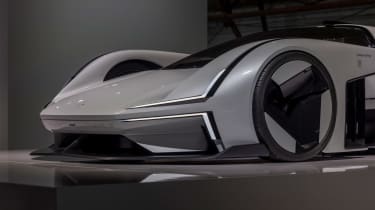Polestar’s first supercar could emerge from the Synergy concept
Polestar has a lot on its product development plate at the moment, but when the range takes shape a halo supercar is in its sights…
Polestar is an electric car brand with a bold plan, and we’re going to see it rolling out over the next couple of years. Beyond that, the firm’s product development resources could be redirected in the direction of the Synergy concept car first revealed at the 2023 Munich Motor Show. Polestar, you see, would really like to build its own supercar.
Polestar will supplement the existing Polestar 2 with the Polestar 3 family SUV and the Polestar 4 coupe-SUV in 2024. These models are based on underpinnings sourced from Polestar’s Geely Group owners, and much of the technology is shared with equivalent models from Volvo, Smart and, a name slightly less familiar to UK motorists, Zeekr. Then things will get a bit more interesting.
> Polestar 2 2023 review – do powertrain updates breath life into Swedish EV?
In 2025 it’s on to the Polestar 5 - a flagship 874bhp Porsche Taycan rival with a bespoke bonded aluminium architecture developed in the UK at the firm’s development facility at the Horbia MIRA proving ground near Nuneaton. Next up will be the Polestar 6, another car that could pique the interest of evo readers.
The 6 will be the second car on that aluminium platform, a roadster or coupe that’s expected to closely reflect the Polestar 02 and LA concept cars. Due in around 2026, the Polestar 6 was briefly pictured with aggressive race-inspired spoilers and Polestar’s high performance BST livery at the recent Polestar Day event in Los Angeles. The image flashed up on screen came as an apparent nod to the brand’s origins as Polestar Racing, Volvo’s factory touring car team and a statement of intent where the 6 is concerned. The 6 will share the 874bhp and 664lb ft EV drivetrain of the Polestar 5 with 800-volt architecture and all-wheel drive delivered by twin electric motors - one front and one rear.
Polestar design boss, Maximilian Missoni, said of the Polestar 6: ‘Our dream is to create the every day sports car for the electric age'. And just as the 5 has benchmarked the Porsche Taycan as a rival, the 6 seems certain to be designed as an electric 911 rival around the time that Porsche will be forced to adopt pure electric power for its iconic model line.
All of that brings us into the unknown as far as Polestar’s model plans are concerned. Sometime after 2027 with the ambitious model range expansion plan brought to fruition, would attention turn to the Polestar Synergy concept and the prospect of a Polestar supercar? Missoni does not dismiss it. 'I can see the brand having the pull to do that, yes,' he says. 'At the moment it’s all hands on deck to deliver what we have to deliver, but I wouldn’t say it couldn’t be done.’
As Polestar insiders pointed out to evo when pressed on the issue, the brand doesn’t do concept cars without clear production relevance. The catch is that the Polestar Synergy is not your typical Polestar concept car. As you might even guess from looking at the single-seater with its gaping aero channels and voluptuous, wheel-hugging arches, it was created as an amalgamation of the winning entries for a design competition sponsored by toy car brand Hot Wheels. A judging panel selected two exterior designs and one interior design from 10 finalists and Polestar merged them into the appropriately named Synergy.
With even the legal ownership of the design a grey area, not to mention the impractical single seat layout and the concept car lines, it’s a safe bet that Missoni and his team would be looking to put their own mark on any production Polestar supercar. That’s despite the fact that the Synergy, at 1.040mm tall and 4,560mm long, was designed with space to accommodate the necessary batteries and motors.
It’s also a safe bet that the development work for any such model would fall to Polestar’s MIRA development base, utilising the unrivalled motorsport expertise in the UK. Missoni suggested that the vehicle would not use the aluminium chassis developed for the 5 and 6 but would instead get a purpose-built monocoque.
If we do see a supercar from Polestar, there’s a good chance it could incorporate the brand’s experimental new battery technology. Developed with partner StoreDot, the system is dubbed XFC, short for ‘extreme fast charging’. Billed as a stepping stone to solid state batteries in electric cars that Polestar believes are still a decade away from production, XFC adapts existing battery chemistry to achieve charging speeds that are claimed to add 100 miles of range in five minutes.
The plan is for the tech, which used silicone anodes in batteries rather than the traditional graphite, to be trialled in-car using a prototype Polestar 5 in 2024, but a working battery prototype was shown to evo at the 2023 Polestar Day event. Raising the prospect of a 0-100% charge for most electric cars in under 20 minutes using existing 350kW charger technology, the StoreDot tech is also claimed to generate no more heat or battery degradation than conventional charging.







